A Conceptual Hybrid Approach from a Multicriteria Perspective for Sustainable Third-Party Reverse Logistics Provider Identification
Abstract
:1. Introduction
- Developing an approach for service logistics provider determination for the first time under the neutrosophic environment to handle vague and uncertain data.
- Introducing hybrid MCDM techniques namely, neutrosophic AHP and neutrosophic TOPSIS.
- The substantiation that neutrosophic AHP-TOPSIS approach can efficiently handle linguistic uncertainty.
- Four sustainability aspects were evaluated including social, economic, ecological, and risk.
- The utility of the suggested technique is demonstrated with a case study.

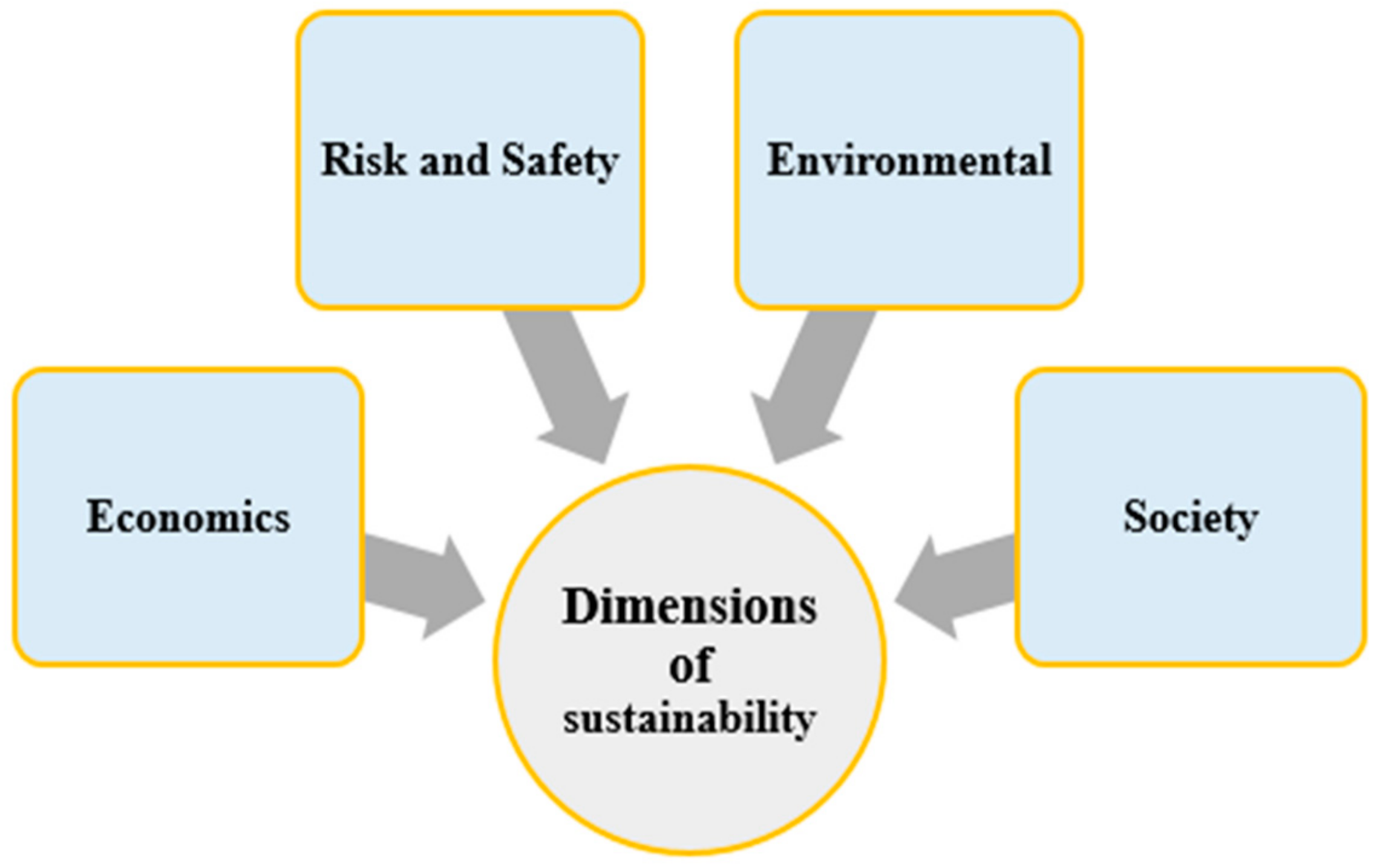
2. Literature Review
3. Development Methodology
- Step 1. The committee, comprising experts and decision makers determine the most important key dimensions of sustainability to be taken into consideration, and determine the most important subindices related to dimensions that affect the problem in a significant way. Then, subindices are confirmed by the panel to confirm their suitability for the problem at hand.
- Step 2. The committee determines the most important alternatives, and their conformity and suitability with the specifications that are required to choose the best alternative from those available.
- Step 3. Then, after the criteria and the most important alternatives have been identified, the committee begins to express their views in evaluating the criteria by using semantic terms as in Table 1 and Table 2, to facilitate the evaluation process. When creating these terms, the contradiction in satisfaction and dissatisfaction of the decision makers is taken into account.
- Step 4. We evaluate the criteria priority using pairwise comparisons, assign linguistic variables and T2NN from Table 1 to the assessment matrices to determine which aspect is important. In the pairwise assessment matrix, the outcome of demonstrates the relative significance of the element on row (i) over the element on column (j). The mutual value of the term is utilized when the element (j) is more significant than element (i), as shown in Equation (5).
- Step 5. We convert the neutrosophic pairwise comparison matrix to a deterministic matrix as in Equation (7), using the score function of T2NNs according to Equation (6):
- Step 6. Determine the dimensions weights as follows, standardize the column admissions by dividing each entry by the total of the column, and take the total of the row means.
- Step 7. We check consistency of all matrices, which is one of the basic and significant conditions in the AHP method, to shows the consistency of expert opinions.
- Step 8. Structure the neutrosophic judgment matrix among their subindices and the 3PRLPs with semantic scales as in Table 2. Then, we convert it to its equivalent by T2NNs in Table 2 where m indicates fundamental dimensions, and n indicates the 3PRLPs according to Equation (8).Subsequently, we convert the neutrosophic pairwise comparison matrix to a crisp value matrix according to Equation (9), according to Equation (6).
- Step 9. We enhance the comparable capability by normalizing the neutrosophic judgment matrix by using Equation (10).where i designates the substitutes, j indicates the selected dimensions, and indicates i substitute under the j dimension to be measured.
- Step 10. We obtain the final weights of each dimension that are estimated with neutrosophic AHP.
- Step 11. We multiply the normalized decision matrix by the achieved weights computed by neutrosophic AHP as Equation (12), obtain the weighted normalized matrix k.
- Step 12. Recognize the PPS and the NPS according to the following Equations (13) and (14).
- Step 13. Determine the Euclidean distance among the positive and negative perfect solution and , respectively, by applying Equations (15) and (16).
- Step 14. Determine the proportional closeness () to the and for each 3PRLP by applying the Equation (17), then rank the 3PRLPs according to value of .
4. Application of the Framework
4.1. A Case Study
4.2. Data Gathering
4.3. Neutrosophic AHP-TOPSIS Results
5. Comparative Analysis
6. Sensitivity Analysis
7. Managerial Implications
8. Concluding Remarks
Author Contributions
Funding
Institutional Review Board Statement
Informed Consent Statement
Data Availability Statement
Acknowledgments
Conflicts of Interest
Ethical Approval
Appendix A
| Factor EDI1 | EQD11 | ECD12 | EED13 | EID14 | EFD15 | EAD16 |
|---|---|---|---|---|---|---|
| EQD11 | - | 〈VSE〉 | 〈WIE〉 | 〈JIE〉 | 〈EIE〉 | 〈EPD〉 |
| ECD12 | 1/〈VSE〉 | - | 〈JIE〉 | 〈JIE〉 | 〈EPD〉 | 〈EIE〉 |
| EED13 | 1/〈WIE〉 | 1/〈JIE〉 | - | 〈EIE〉 | 〈JIE〉 | 〈EPD〉 |
| EID14 | 1/〈JIE〉 | 1/〈JJIE〉 | 1/〈EIE〉 | - | 〈EIE〉 | 〈WIE〉 |
| EFD15 | 1/〈EIE〉 | 1/〈EPD〉 | 1/〈JIE〉 | 1/〈EIE〉 | - | 〈EPD〉 |
| EAD16 | 1/〈EPD〉 | 1/〈EIE〉 | 1/〈EPD〉 | 1/〈WIE〉 | 1/〈EPD〉 | - |
| Factor EDI1 | EQD11 | ECD12 | EED13 | EID14 | EFD15 | EAD16 | Weights |
|---|---|---|---|---|---|---|---|
| EQD11 | 0.5 | 0.10 | |||||
| ECD12 | 0.5 | 0.11 | |||||
| EED13 | 0.5 | 0.18 | |||||
| EID14 | 0.5 | 0.16 | |||||
| EFD15 | 0.5 | 0.21 | |||||
| EAD16 | 0.5 | 0.23 |
| Factor NDI2 | NGD21 | NRD22 | NED23 | NFD24 | NCD25 | NDD26 |
|---|---|---|---|---|---|---|
| NGD21 | - | 〈VSE〉 | 〈VSE〉 | 〈WIE〉 | 〈EIE〉 | 〈EPD〉 |
| NRD22 | 1/〈VSE〉 | - | 〈JIE〉 | 〈JIE〉 | 〈JIE〉 | 〈EIE〉 |
| NED23 | 1/〈VSE〉 | 1/〈JIE〉 | - | 〈EIE〉 | 〈JIE〉 | 〈EPD〉 |
| NFD24 | 1/〈WIE〉 | 1/〈JIE〉 | 1/〈EIE〉 | - | 〈EIE〉 | 〈JIE〉 |
| NCD25 | 1/〈EIE〉 | 1/〈JIE〉 | 1/〈JIE〉 | 1/〈EIE〉 | - | 〈EIE〉 |
| NDD26 | 1/〈EPD〉 | 1/〈EIE〉 | 1/〈EPD〉 | 1/〈JIE〉 | 1/〈EIE〉 | - |
| Factor NDI2 | NGD21 | NRD22 | NED23 | NFD24 | NCD25 | NDD26 | Weights |
|---|---|---|---|---|---|---|---|
| NGD21 | 0.5 | 0.11 | |||||
| NRD22 | 0.5 | 0.09 | |||||
| NED23 | 0.5 | 0.14 | |||||
| NFD24 | 0.5 | 0.19 | |||||
| NCD25 | 0.5 | 0.23 | |||||
| NDD26 | 0.5 | 0.24 |
| Factor SDI3 | SHD31 | SED32 | SOD33 | SSD34 | STD35 |
|---|---|---|---|---|---|
| SHD31 | - | 〈VSE〉 | 〈JIE〉 | 〈EIE〉 | 〈WIE〉 |
| SED32 | 1/〈VSE〉 | - | 〈VSE〉 | 〈JIE〉 | 〈WIE〉 |
| SOD33 | 1/〈JIE〉 | 1/〈VSE〉 | - | 〈EIE〉 | 〈JIE〉 |
| SSD34 | 1/〈EIE〉 | 1/〈JIE〉 | 1/〈EIE〉 | - | 〈EIE〉 |
| STD35 | 1/〈EIE〉 | 1/〈WIE〉 | 1/〈JIE〉 | 1/〈EIE〉 | - |
| Factor SDI3 | SHD31 | SED32 | SOD33 | SSD34 | STD35 | Weights |
|---|---|---|---|---|---|---|
| SHD31 | 0.5 | 0.10 | ||||
| SED32 | 0.5 | 0.14 | ||||
| SOD33 | 0.5 | 0.16 | ||||
| SSD34 | 0.5 | 0.23 | ||||
| STD35 | . | 0.5 | 0.37 |
| Factor RDI4 | ROD41 | RRD42 | RMD43 | RSD44 |
|---|---|---|---|---|
| ROD41 | - | 〈JIE〉 | 〈VSE〉 | 〈EIE〉 |
| RRD42 | 1/〈JIE〉 | - | 〈JIE〉 | 〈WIE〉 |
| RMD43 | 1/〈VSE〉 | 1/〈JIE〉 | - | 〈EPD〉 |
| RSD44 | 1/〈EIE〉 | 1/〈WIE〉 | 1/〈EPD〉 | - |
| Factor RDI4 | ROD41 | RRD42 | RMD43 | RSD44 | Weights |
|---|---|---|---|---|---|
| ROD41 | 0.5 | 0.24 | |||
| RRD42 | 0.5 | 0.19 | |||
| RMD43 | 0.5 | 0.26 | |||
| RSD44 | 0.5 | 0.31 |
| 3PRLPs | Subindices | ||||||||||||||||||||
|---|---|---|---|---|---|---|---|---|---|---|---|---|---|---|---|---|---|---|---|---|---|
| EQD11 | ECD12 | EED13 | EID14 | EFD15 | EAD16 | NGD21 | NRD22 | NED23 | NFD24 | NCD25 | NDD26 | SHD31 | SED32 | SOD33 | SSD34 | STD35 | ROD41 | RRD42 | RMD43 | RSD44 | |
| 3PRLPs1 | 〈VPR〉 | 〈MPR〉 | 〈VGD〉 | 〈GOD〉 | 〈VPR〉 | 〈MPR〉 | 〈MPR〉 | 〈VPR〉 | 〈MPR〉 | 〈MGD〉 | 〈FAI〉 | 〈MGD〉 | 〈MPR〉 | 〈VGD〉 | 〈POR〉 | 〈MPR〉 | 〈FAI〉 | 〈GOD〉 | 〈POR〉 | 〈GOD〉 | 〈MPR〉 |
| 3PRLPs2 | 〈MPR〉 | 〈VPR〉 | 〈MPR〉 | 〈MGD〉 | 〈FAI〉 | 〈MGD〉 | 〈POR〉 | 〈GOD〉 | 〈FAI〉 | 〈MPR〉 | 〈FAI〉 | 〈VPR〉 | 〈MPR〉 | 〈MGD〉 | 〈VGD〉 | 〈VPR〉 | 〈MPR〉 | 〈VGD〉 | 〈FAI〉 | 〈MGD〉 | 〈VGD〉 |
| 3PRLPs3 | 〈POR〉 | 〈GOD〉 | 〈FAI〉 | 〈MPR〉 | 〈FAI〉 | 〈VPR〉 | 〈MPR〉 | 〈VPR〉 | 〈POR〉 | 〈FAI〉 | 〈MPR〉 | 〈FAI〉 | 〈FAI〉 | 〈MPR〉 | 〈VPR〉 | 〈MPR〉 | 〈MGD〉 | 〈FAI〉 | 〈GOD〉 | 〈MPR〉 | 〈VPR〉 |
| 3PRLPs4 | 〈FAI〉 | 〈VPR〉 | 〈MPR〉 | 〈FAI〉 | 〈MPR〉 | 〈FAI〉 | 〈MPR〉 | 〈VPR〉 | 〈POR〉 | 〈MGD〉 | 〈FAI〉 | 〈MGD〉 | 〈MPR〉 | 〈VGD〉 | 〈POR〉 | 〈MPR〉 | 〈FAI〉 | 〈GOD〉 | 〈POR〉 | 〈GOD〉 | 〈MPR〉 |
| 3PRLPs5 | 〈MGD〉 | 〈VGD〉 | 〈VPR〉 | 〈MPR〉 | 〈VGD〉 | 〈FAI〉 | 〈POR〉 | 〈GOD〉 | 〈FAI〉 | 〈MPR〉 | 〈FAI〉 | 〈VPR〉 | 〈MPR〉 | 〈MPR〉 | 〈VPR〉 | 〈MPR〉 | 〈MGD〉 | 〈FAI〉 | 〈MGD〉 | 〈MPR〉 | 〈VPR〉 |
| 3PRLPs6 | 〈GOD〉 | 〈MPR〉 | 〈VPR〉 | 〈MGD〉 | 〈VPR〉 | 〈MPR〉 | 〈GOD〉 | 〈MPR〉 | 〈VPR〉 | 〈MPR〉 | 〈VPR〉 | 〈POR〉 | 〈GOD〉 | 〈MPR〉 | 〈VPR〉 | 〈MPR〉 | 〈VPR〉 | 〈MPR〉 | 〈FAI〉 | 〈MPR〉 | 〈FAI〉 |
| 3PRLPs7 | 〈VGD〉 | 〈POR〉 | 〈MPR〉 | 〈FAI〉 | 〈GOD〉 | 〈POR〉 | 〈GOD〉 | 〈MPR〉 | 〈GOD〉 | 〈MPR〉 | 〈VPR〉 | 〈MGD〉 | 〈VPR〉 | 〈MPR〉 | 〈GOD〉 | 〈POR〉 | 〈GOD〉 | 〈FAI〉 | 〈MPR〉 | 〈FAI〉 | 〈VPR〉 |
| 3PRLPs | EQD11 | ECD12 | EED13 | EID14 | EFD15 | EAD16 | NGD21 |
|---|---|---|---|---|---|---|---|
| 3PRLPs1 | |||||||
| 3PRLPs2 | |||||||
| 3PRLPs3 | |||||||
| 3PRLPs4 | |||||||
| 3PRLPs5 | |||||||
| 3PRLPs6 | |||||||
| 3PRLPs7 | |||||||
| 3PRLPs | NRD22 | NED23 | NFD24 | NCD25 | NDD26 | SHD31 | SED32 |
| 3PRLPs1 | |||||||
| 3PRLPs2 | |||||||
| 3PRLPs3 | |||||||
| 3PRLPs4 | |||||||
| 3PRLPs5 | |||||||
| 3PRLPs6 | |||||||
| 3PRLPs7 | |||||||
| 3PRLPs | SOD33 | SSD34 | STD35 | ROD41 | RRD42 | RMD43 | RSD44 |
| 3PRLPs1 | |||||||
| 3PRLPs2 | |||||||
| 3PRLPs3 | |||||||
| 3PRLPs4 | |||||||
| 3PRLPs5 | |||||||
| 3PRLPs6 | |||||||
| 3PRLPs7 |
| 3PRLPs | Subindices | ||||||||||||||||||||
|---|---|---|---|---|---|---|---|---|---|---|---|---|---|---|---|---|---|---|---|---|---|
| EQD11 | ECD12 | EED13 | EID14 | EFD15 | EAD16 | NGD21 | NRD22 | NED23 | NFD24 | NCD25 | NDD26 | SHD31 | SED32 | SOD33 | SSD34 | STD35 | ROD41 | RRD42 | RMD43 | RSD44 | |
| 3PRLPs1 | 0.24 | 0.5 | 0.9 | 0.8 | 0.24 | 0.8 | 0.5 | 0.24 | 0.3 | 0.7 | 0.5 | 0.7 | 0.5 | 0.9 | 0.3 | 0.5 | 0.5 | 0.8 | 0.3 | 0.8 | 0.5 |
| 3PRLPs2 | 0.5 | 0.24 | 0.3 | 0.7 | 0.5 | 0.7 | 0.3 | 0.8 | 0.5 | 0.5 | 0.5 | 0.24 | 0.3 | 0.7 | 0.9 | 0.24 | 0.5 | 0.9 | 0.5 | 0.7 | 0.9 |
| 3PRLPs3 | 0.3 | 0.8 | 0.5 | 0.5 | 0.5 | 0.24 | 0.5 | 0.24 | 0.3 | 0.5 | 0.5 | 0.5 | 0.5 | 0.5 | 0.24 | 0.3 | 0.7 | 0.5 | 0.8 | 0.5 | 0.24 |
| 3PRLPs4 | 0.5 | 0.24 | 0.3 | 0.5 | 0.5 | 0.5 | 0.5 | 0.24 | 0.3 | 0.7 | 0.5 | 0.7 | 0.5 | 0.9 | 0.3 | 0.5 | 0.5 | 0.8 | 0.3 | 0.8 | 0.5 |
| 3PRLPs5 | 0.7 | 0.9 | 0.24 | 0.5 | 0.9 | 0.5 | 0.3 | 0.8 | 0.5 | 0.5 | 0.5 | 0.24 | 0.3 | 0.5 | 0.24 | 0.3 | 0.7 | 0.5 | 0.7 | 0.5 | 0.24 |
| 3PRLPs6 | 0.8 | 0.5 | 0.24 | 0.7 | 0.24 | 0.3 | 0.8 | 0.5 | 0.24 | 0.7 | 0.24 | 0.3 | 0.8 | 0.5 | 0.24 | 0.5 | 0.24 | 0.3 | 0.5 | 0.5 | 0.5 |
| 3PRLPs7 | 0.9 | 0.3 | 0.5 | 0.5 | 0.8 | 0.3 | 0.8 | 0.5 | 0.8 | 0.5 | 0.24 | 0.7 | 0.24 | 0.3 | 0.8 | 0.3 | 0.8 | 0.5 | 0.5 | 0.5 | 0.24 |
| 3PRLPs | EQD11 | ECD12 | EED13 | EID14 | EFD15 | EAD16 | NGD21 | NRD22 | NED23 | NFD24 | NCD25 |
|---|---|---|---|---|---|---|---|---|---|---|---|
| 3PRLPs1 | 0.149 | 0.341 | 0.71 | 0.49 | 0.158 | 0.585 | 0.336 | 0.172 | 0.248 | 0.4454 | 0.428 |
| 3PRLPs2 | 0.311 | 0.163 | 0.237 | 0.43 | 0.329 | 0.512 | 0.202 | 0.572 | 0.413 | 0.3181 | 0.428 |
| 3PRLPs3 | 0.186 | 0.545 | 0.395 | 0.31 | 0.329 | 0.176 | 0.336 | 0.172 | 0.248 | 0.3181 | 0.428 |
| 3PRLPs4 | 0.311 | 0.163 | 0.237 | 0.31 | 0.329 | 0.366 | 0.336 | 0.172 | 0.248 | 0.4454 | 0.428 |
| 3PRLPs5 | 0.435 | 0.613 | 0.189 | 0.31 | 0.591 | 0.366 | 0.202 | 0.572 | 0.413 | 0.3181 | 0.428 |
| 3PRLPs6 | 0.497 | 0.341 | 0.189 | 0.43 | 0.158 | 0.22 | 0.538 | 0.358 | 0.198 | 0.4454 | 0.205 |
| 3PRLPs7 | 0.559 | 0.204 | 0.395 | 0.31 | 0.526 | 0.22 | 0.538 | 0.358 | 0.66 | 0.3181 | 0.205 |
| 3PRLPs | NDD26 | SHD31 | SED32 | SOD33 | SSD34 | STD35 | ROD41 | RRD42 | RMD43 | RSD44 | |
| 3PRLPs1 | 0.5 | 0.392 | 0.524 | 0.223 | 0.482 | 0.321 | 0.467 | 0.21 | 0.48 | 0.38 | |
| 3PRLPs2 | 0.17 | 0.235 | 0.408 | 0.67 | 0.231 | 0.321 | 0.526 | 0.35 | 0.42 | 0.68 | |
| 3PRLPs3 | 0.36 | 0.392 | 0.291 | 0.179 | 0.289 | 0.449 | 0.292 | 0.56 | 0.3 | 0.18 | |
| 3PRLPs4 | 0.5 | 0.392 | 0.524 | 0.223 | 0.482 | 0.321 | 0.467 | 0.21 | 0.48 | 0.38 | |
| 3PRLPs5 | 0.17 | 0.235 | 0.291 | 0.179 | 0.289 | 0.449 | 0.292 | 0.49 | 0.3 | 0.18 | |
| 3PRLPs6 | 0.22 | 0.627 | 0.291 | 0.179 | 0.482 | 0.154 | 0.175 | 0.35 | 0.3 | 0.38 | |
| 3PRLPs7 | 0.5 | 0.188 | 0.175 | 0.596 | 0.289 | 0.513 | 0.292 | 0.35 | 0.3 | 0.18 | |
| 3PRLPs | EQD11 | ECD12 | EED13 | EID14 | EFD15 | EAD16 | NGD21 | NRD22 | NED23 | NFD24 | NCD25 |
|---|---|---|---|---|---|---|---|---|---|---|---|
| 3PRLPs1 | 0.003 | 0.01 | 0.028 | 0.01 | 0.008 | 0.029 | 0.007 | 0.002 | 0.005 | 0.0134 | 0.017 |
| 3PRLPs2 | 0.006 | 0.005 | 0.009 | 0.01 | 0.016 | 0.026 | 0.004 | 0.006 | 0.008 | 0.0095 | 0.017 |
| 3PRLPs3 | 0.004 | 0.016 | 0.016 | 0.01 | 0.016 | 0.009 | 0.007 | 0.002 | 0.005 | 0.0095 | 0.017 |
| 3PRLPs4 | 0.006 | 0.005 | 0.009 | 0.01 | 0.016 | 0.018 | 0.007 | 0.002 | 0.005 | 0.0134 | 0.017 |
| 3PRLPs5 | 0.009 | 0.018 | 0.008 | 0.01 | 0.03 | 0.018 | 0.004 | 0.006 | 0.008 | 0.0095 | 0.017 |
| 3PRLPs6 | 0.01 | 0.01 | 0.008 | 0.01 | 0.008 | 0.011 | 0.011 | 0.004 | 0.004 | 0.0134 | 0.008 |
| 3PRLPs7 | 0.011 | 0.006 | 0.016 | 0.01 | 0.026 | 0.011 | 0.011 | 0.004 | 0.013 | 0.0095 | 0.008 |
| 0.011 | 0.018 | 0.028 | 0.01 | 0.03 | 0.029 | 0.011 | 0.006 | 0.013 | 0.0134 | 0.017 | |
| 0.003 | 0.005 | 0.008 | 0.01 | 0.008 | 0.009 | 0.004 | 0.002 | 0.004 | 0.0095 | 0.008 | |
| 3PRLPs | NDD26 | SHD31 | SED32 | SOD33 | SSD34 | STD35 | ROD41 | RRD42 | RMD43 | RSD44 | |
| 3PRLPs1 | 0.03 | 0.196 | 0.016 | 0.009 | 0.029 | 0.032 | 0.042 | 0.01 | 0.05 | 0.04 | |
| 3PRLPs2 | 0.01 | 0.118 | 0.012 | 0.027 | 0.014 | 0.032 | 0.047 | 0.02 | 0.04 | 0.08 | |
| 3PRLPs3 | 0.02 | 0.196 | 0.009 | 0.007 | 0.017 | 0.045 | 0.026 | 0.04 | 0.03 | 0.02 | |
| 3PRLPs4 | 0.03 | 0.196 | 0.016 | 0.009 | 0.029 | 0.032 | 0.042 | 0.01 | 0.05 | 0.04 | |
| 3PRLPs5 | 0.01 | 0.118 | 0.009 | 0.007 | 0.017 | 0.045 | 0.026 | 0.03 | 0.03 | 0.02 | |
| 3PRLPs6 | 0.01 | 0.314 | 0.009 | 0.007 | 0.029 | 0.015 | 0.016 | 0.02 | 0.03 | 0.04 | |
| 3PRLPs7 | 0.03 | 0.094 | 0.005 | 0.024 | 0.017 | 0.051 | 0.026 | 0.02 | 0.03 | 0.02 | |
| 0.03 | 0.314 | 0.016 | 0.027 | 0.029 | 0.051 | 0.047 | 0.04 | 0.05 | 0.08 | ||
| 0.01 | 0.094 | 0.005 | 0.007 | 0.014 | 0.015 | 0.016 | 0.01 | 0.03 | 0.02 | ||
References
- Beiler, B.C.; Ignácio, P.S.A.; Pacagnella Júnior, A.C.; Anholon, R.; Rampasso, I.S. Reverse logistics system analysis of a Brazilian beverage company: An exploratory study. J. Clean. Prod. 2020, 274, 122624. [Google Scholar] [CrossRef]
- Guo, J.; Wang, X.; Fan, S.; Gen, M. Forward and reverse logistics network and route planning under the environment of low-carbon emissions: A case study of Shanghai fresh food E-commerce enterprises. Comput. Ind. Eng. 2017, 106, 351–360. [Google Scholar] [CrossRef]
- Zarbakhshnia, N.; Soleimani, H.; Ghaderi, H. Sustainable third-party reverse logistics provider evaluation and selection using fuzzy SWARA and developed fuzzy COPRAS in the presence of risk criteria. Appl. Soft Comput. 2018, 65, 307–319. [Google Scholar] [CrossRef]
- Zarbakhshnia, N.; Wu, Y.; Govindan, K.; Soleimani, H. A novel hybrid multiple attribute decision-making approach for outsourcing sustainable reverse logistics. J. Clean. Prod. 2020, 242, 118461. [Google Scholar] [CrossRef]
- Bai, C.; Sarkis, J. Integrating and extending data and decision tools for sustainable third-party reverse logistics provider selection. Comput. Oper. Res. 2019, 110, 188–207. [Google Scholar] [CrossRef]
- Carter, C.R.; Rogers, D.S. A framework of sustainable supply chain management: Moving toward new theory. Int. J. Phys. Distrib. Logist. Manag. 2008, 38, 360–387. [Google Scholar] [CrossRef]
- John, S.T.; Sridharan, R.; Ram Kumar, P.N. Reverse logistics network design: A case of mobile phones and digital cameras. Int. J. Adv. Manuf. Technol. 2018, 94, 615–631. [Google Scholar] [CrossRef]
- Sirisawat, P.; Kiatcharoenpol, T. Fuzzy AHP-TOPSIS approaches to prioritizing solutions for reverse logistics barriers. Comput. Ind. Eng. 2018, 117, 303–318. [Google Scholar] [CrossRef]
- Kazemi, N.; Modak, N.M.; Govindan, K. A review of reverse logistics and closed loop supply chain management studies published in IJPR: A bibliometric and content analysis. Int. J. Prod. Res. 2019, 57, 4937–4960. [Google Scholar] [CrossRef] [Green Version]
- Kannan, G.; Pokharel, S.; Sasi Kumar, P. A hybrid approach using ISM and fuzzy TOPSIS for the selection of reverse logistics provider. Resour. Conserv. Recycl. 2009, 54, 28–36. [Google Scholar] [CrossRef]
- Budak, A. Sustainable reverse logistics optimization with triple bottom line approach: An integration of disassembly line balancing. J. Clean. Prod. 2020, 270, 122475. [Google Scholar] [CrossRef]
- Pamucar, D.; Chatterjee, K.; Zavadskas, E.K. Assessment of third-party logistics provider using multi-criteria decision-making approach based on interval rough numbers. Comput. Ind. Eng. 2019, 127, 383–407. [Google Scholar] [CrossRef]
- Narayana, S.A.; Pati, R.K.; Padhi, S.S. Market dynamics and reverse logistics for sustainability in the Indian Pharmaceuticals industry. J. Clean. Prod. 2019, 208, 968–987. [Google Scholar] [CrossRef]
- Smarandache, F. Neutrosophy: Neutrosophic Probability, Set, and Logic: Analytic Synthesis & Synthetic Analysis; American Research Press: Santa Fe, NM, USA, 1998. [Google Scholar]
- Zadeh, L.A. Fuzzy sets. Inf. Control. 1965, 8, 338–353. [Google Scholar] [CrossRef] [Green Version]
- Atanassov, K.T. New operations defined over the intuitionistic fuzzy sets. Fuzzy Sets Syst. 1994, 61, 137–142. [Google Scholar] [CrossRef]
- Abdel-Basset, M.; Gamal, A.; Chakrabortty, R.K.; Ryan, M. A new hybrid multi-criteria decision-making approach for location selection of sustainable offshore wind energy stations: A case study. J. Clean. Prod. 2021, 280, 124462. [Google Scholar] [CrossRef]
- Moktadir, M.A.; Dwivedi, A.; Khan, N.S.; Paul, S.K.; Khan, S.A.; Ahmed, S.; Sultana, R. Analysis of risk factors in sustainable supply chain management in an emerging economy of leather industry. J. Clean. Prod. 2021, 283, 124641. [Google Scholar] [CrossRef]
- Vafadarnikjoo, A.; Mishra, N.; Govindan, K.; Chalvatzis, K. Assessment of consumers’ motivations to purchase a remanufactured product by applying Fuzzy Delphi method and single valued neutrosophic sets. J. Clean. Prod. 2018, 196, 230–244. [Google Scholar] [CrossRef] [Green Version]
- Chen, Z.S.; Zhang, X.; Govindan, K.; Wang, X.J.; Chin, K.S. Third-party reverse logistics provider selection: A computational semantic analysis-based multi-perspective multi-attribute decision-making approach. Expert Syst. Appl. 2021, 166, 114051. [Google Scholar] [CrossRef]
- Govindan, K.; Palaniappan, M.; Zhu, Q.; Kannan, D. Analysis of third party reverse logistics provider using interpretive structural modeling. Int. J. Prod. Econ. 2012, 140, 204–211. [Google Scholar] [CrossRef]
- Ansari, Z.N.; Kant, R.; Shankar, R. Evaluation and ranking of solutions to mitigate sustainable remanufacturing supply chain risks: A hybrid fuzzy SWARA-fuzzy COPRAS framework approach. Int. J. Sustain. Eng. 2020, 13, 1–22. [Google Scholar] [CrossRef]
- Ghadimi, P.; Ghassemi Toosi, F.; Heavey, C. A multi-agent systems approach for sustainable supplier selection and order allocation in a partnership supply chain. Eur. J. Oper. Res. 2018, 269, 286–301. [Google Scholar] [CrossRef] [Green Version]
- Govindan, K.; Jha, P.C.; Agarwal, V.; Darbari, J.D. Environmental management partner selection for reverse supply chain collaboration: A sustainable approach. J. Environ. Manag. 2019, 236, 784–797. [Google Scholar] [CrossRef] [PubMed]
- Amirghodsi, S.; Naeini, A.B.; Makui, A. An integrated Delphi-DEMATEL-ELECTRE method on gray numbers to rank technology providers. IEEE Trans. Eng. Manag. 2020, 1–17. [Google Scholar] [CrossRef]
- Abdel-Basset, M.; Saleh, M.; Gamal, A.; Smarandache, F. An approach of TOPSIS technique for developing supplier selection with group decision making under type-2 neutrosophic number. Appl. Soft Comput. J. 2019, 77, 438–452. [Google Scholar] [CrossRef]
- Sasikumar, P.; Kannan, G. Issues in reverse supply chains, part I: End-of-life product recovery and inventory management—An overview. Int. J. Sustain. Eng. 2008, 1, 154–172. [Google Scholar] [CrossRef]
- Turki, S.; Sauvey, C.; Rezg, N. Modelling and optimization of a manufacturing/remanufacturing system with storage facility under carbon cap and trade policy. J. Clean. Prod. 2018, 193, 441–458. [Google Scholar] [CrossRef]
- Prajapati, H.; Kant, R.; Shankar, R. Bequeath life to death: State-of-art review on reverse logistics. J. Clean. Prod. 2019, 211, 503–520. [Google Scholar] [CrossRef]
- Kuşakcı, A.O.; Ayvaz, B.; Cin, E.; Aydın, N. Optimization of reverse logistics network of end of life vehicles under fuzzy supply: A case study for Istanbul metropolitan area. J. Clean. Prod. 2019, 215, 1036–1051. [Google Scholar] [CrossRef]
- Galati, A.; Sabatino, L.; Prinzivalli, C.S.; D′Anna, F.; Scalenghe, R. Strawberry fields forever: That is, how many grams of plastics are used to grow a strawberry? J. Environ. Manag. 2020, 276, 111313. [Google Scholar] [CrossRef] [PubMed]
- Tian, G.; Liu, X.; Zhang, M.; Yang, Y.; Zhang, H.; Lin, Y.; Ma, F.; Wang, X.; Qu, T.; Li, Z. Selection of take-back pattern of vehicle reverse logistics in China via Grey-DEMATEL and Fuzzy-VIKOR combined method. J. Clean. Prod. 2019, 220, 1088–1100. [Google Scholar] [CrossRef]
- Tosarkani, B.M.; Amin, S.H. A multi-objective model to configure an electronic reverse logistics network and third party selection. J. Clean. Prod. 2018, 198, 662–682. [Google Scholar] [CrossRef]
- Tavana, M.; Zareinejad, M.; Di Caprio, D.; Kaviani, M.A. An integrated intuitionistic fuzzy AHP and SWOT method for outsourcing reverse logistics. Appl. Soft Comput. 2016, 40, 544–557. [Google Scholar] [CrossRef]
- Augusto, B. 3PL provider selection by AHP and TOPSIS methodology. Benchmarking Int. J. 2018, 25, 235–252. [Google Scholar] [CrossRef]
- Sarabi, E.P.; Darestani, S.A. Developing a decision support system for logistics service provider selection employing fuzzy MULTIMOORA & BWM in mining equipment manufacturing. Appl. Soft Comput. 2021, 98, 106849. [Google Scholar] [CrossRef]
- Raut, R.D.; Gardas, B.B.; Pushkar, S.; Narkhede, B.E. Third-party logistics service providers selection and evaluation: A hybrid AHP-DEA-COPRAS-G group decision-making approach. Int. J. Procure. Manag. 2019, 12, 632–651. [Google Scholar] [CrossRef]
- Liu, A.; Ji, X.; Lu, H.; Liu, H. The selection of 3PRLs on self-service mobile recycling machine: Interval-valued pythagorean hesitant fuzzy best-worst multi-criteria group decision-making. J. Clean. Prod. 2019, 230, 734–750. [Google Scholar] [CrossRef]
- Govindan, K.; Kadziński, M.; Ehling, R.; Miebs, G. Selection of a sustainable third-party reverse logistics provider based on the robustness analysis of an outranking graph kernel conducted with ELECTRE I and SMAA. Omega 2019, 85, 1–15. [Google Scholar] [CrossRef]
- Jayant, A.; Singh, S.; Garg, S.K. An integrated approach with MOORA, SWARA, and WASPAS methods for selection of 3PLSP. Proc. Int. Conf. Ind. Eng. Oper. Manag. 2018, 2018, 2497–2509. [Google Scholar]
- Mavi, R.K.; Goh, M.; Zarbakhshnia, N. Sustainable third-party reverse logistic provider selection with fuzzy SWARA and fuzzy MOORA in plastic industry. Int. J. Adv. Manuf. Technol. 2017, 91, 2401–2418. [Google Scholar] [CrossRef]
- Prakash, C.; Barua, M.K. An analysis of integrated robust hybrid model for third-party reverse logistics partner selection under fuzzy environment. Resour. Conserv. Recycl. 2016, 108, 63–81. [Google Scholar] [CrossRef]
- Senthil, S.; Srirangacharyulu, B.; Ramesh, A. A robust hybrid multi-criteria decision making methodology for contractor evaluation and selection in third-party reverse logistics. Expert Syst. Appl. 2014, 41, 50–58. [Google Scholar] [CrossRef]
- Saaty, R.W. The analytic hierarchy process—what it is and how it is used. Math. Model. 1987, 9, 161–176. [Google Scholar] [CrossRef] [Green Version]
- Shaik, M.N.; Abdul-Kader, W. A hybrid multiple criteria decision making approach for measuring comprehensive performance of reverse logistics enterprises. Comput. Ind. Eng. 2018, 123, 9–25. [Google Scholar] [CrossRef]
- Hwang, C.L.; Yoon, K. Multiple attribute decision making: Methods and applications a state-of-the-art survey. In Multiple Attribute Decision Making: An Introduction; Hwang, C.L., Yoon, K., Eds.; Springer: Berlin/Heidelberg, Germany, 1981; pp. 58–191. [Google Scholar] [CrossRef]
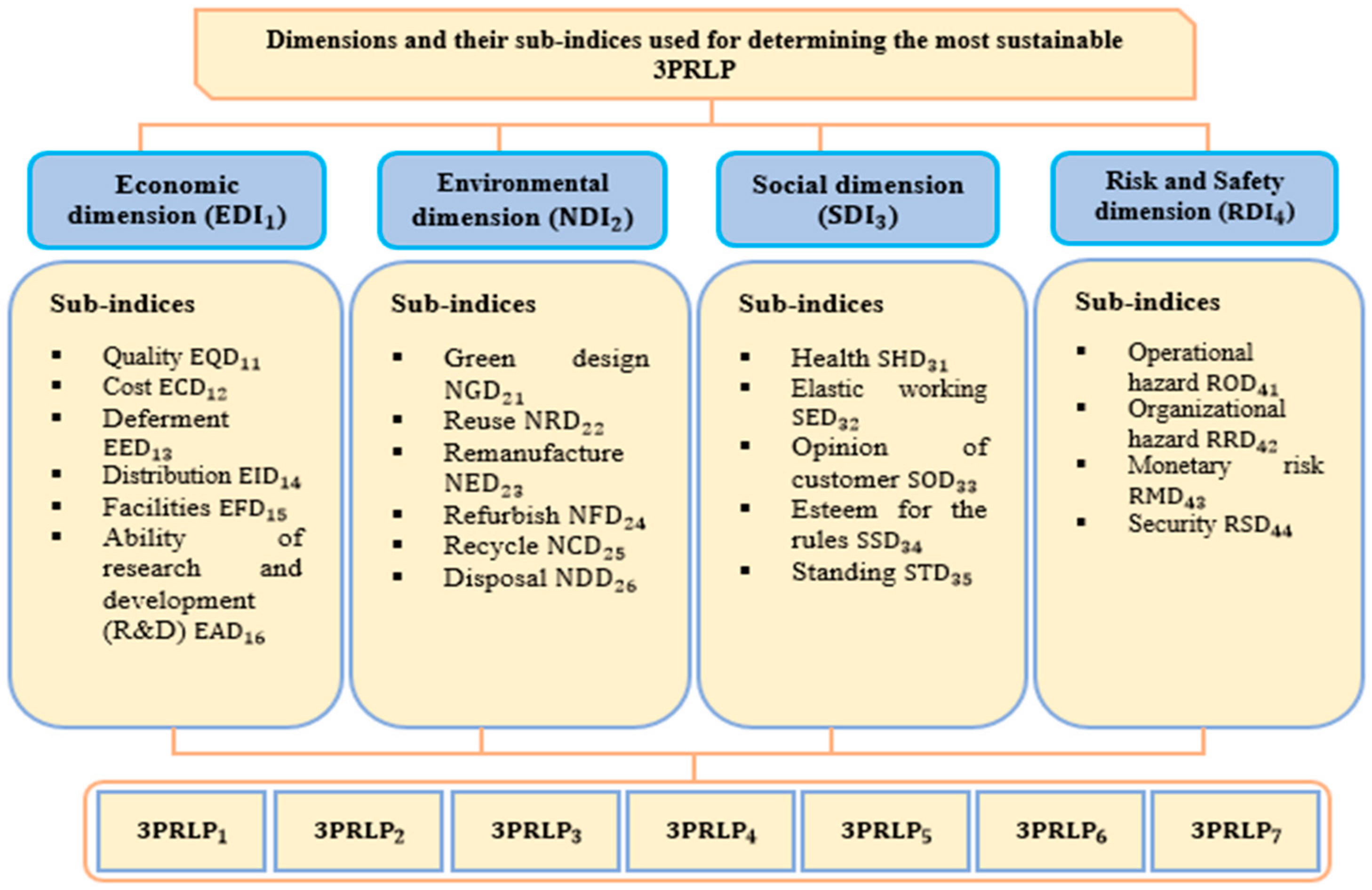

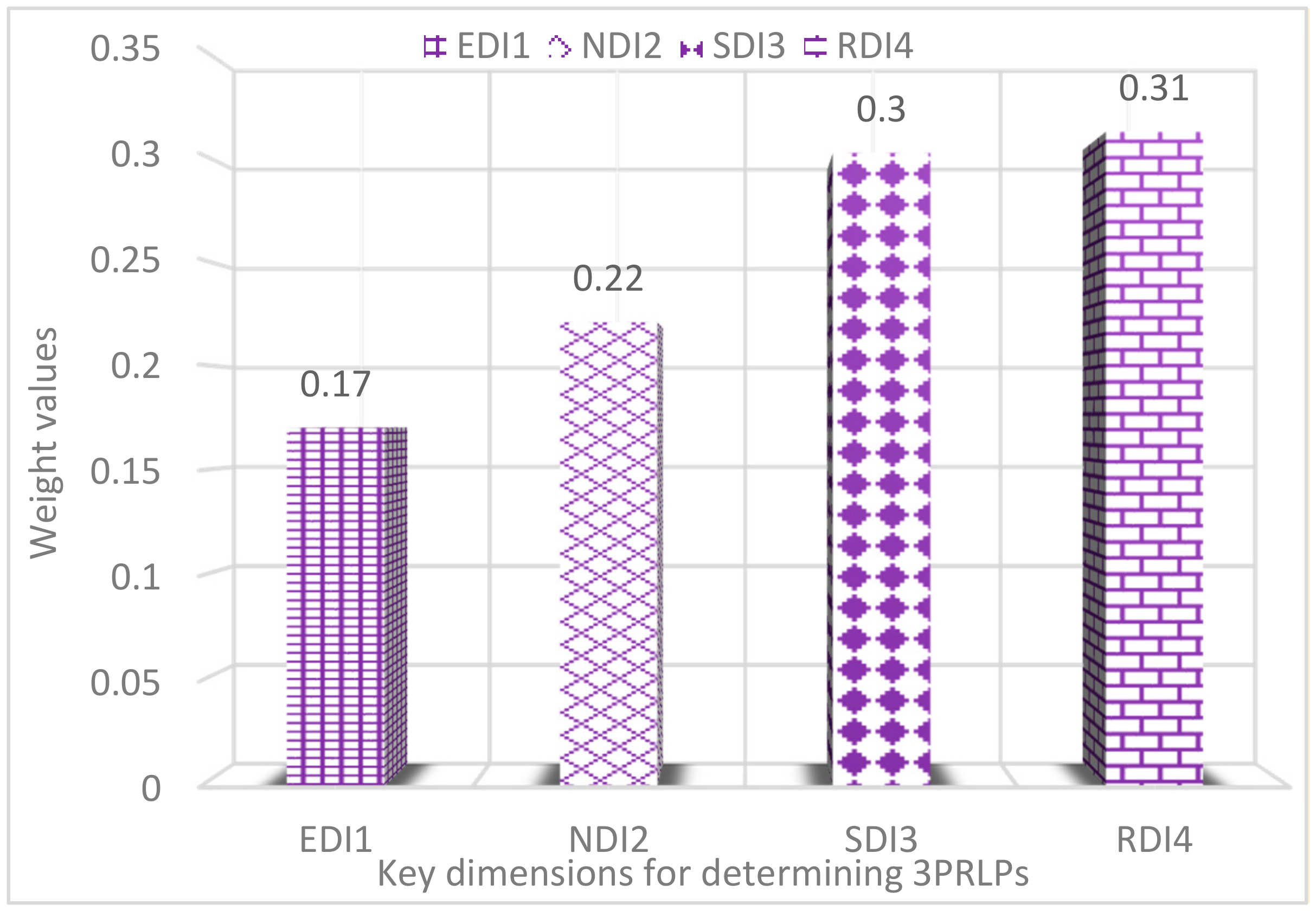

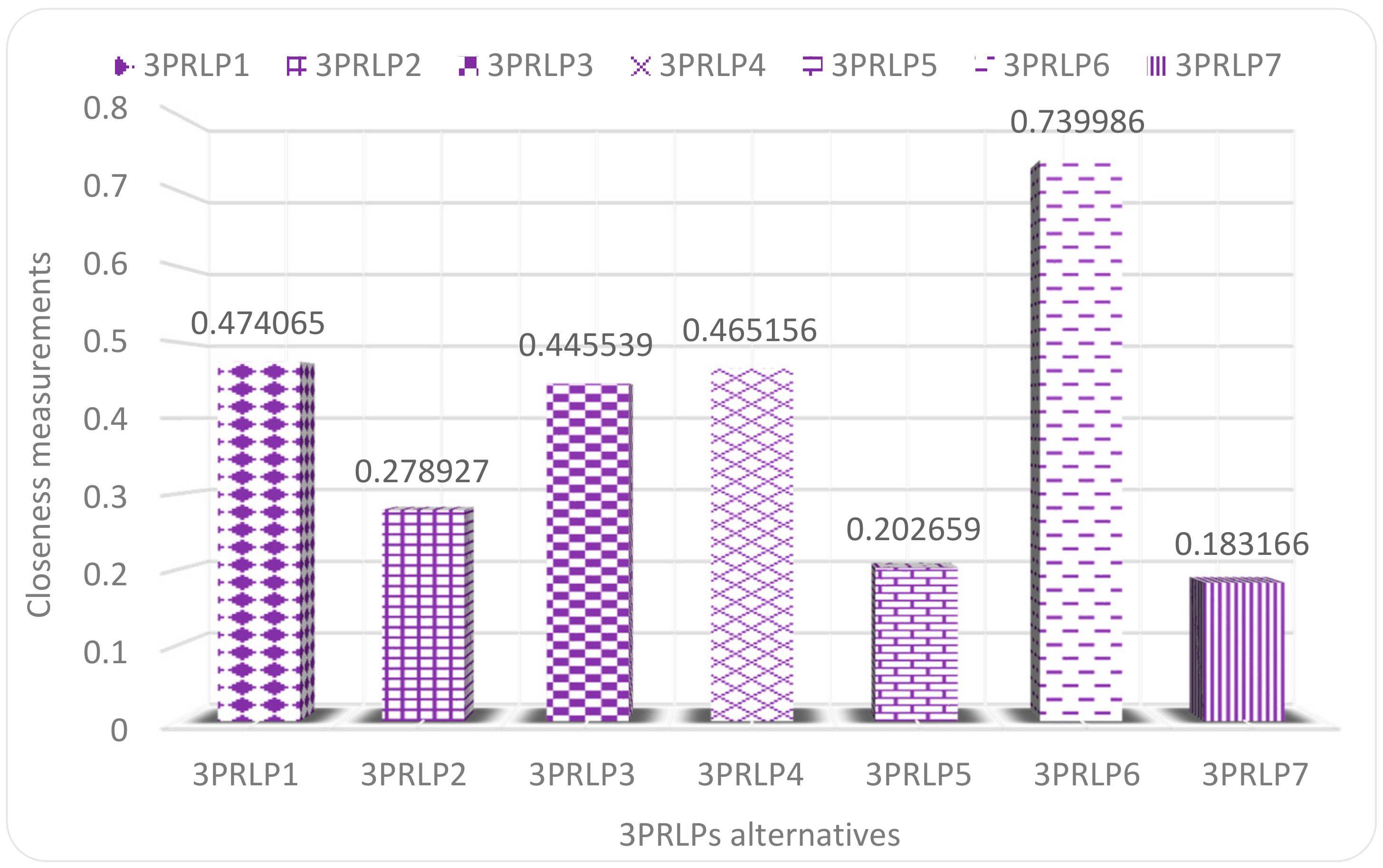
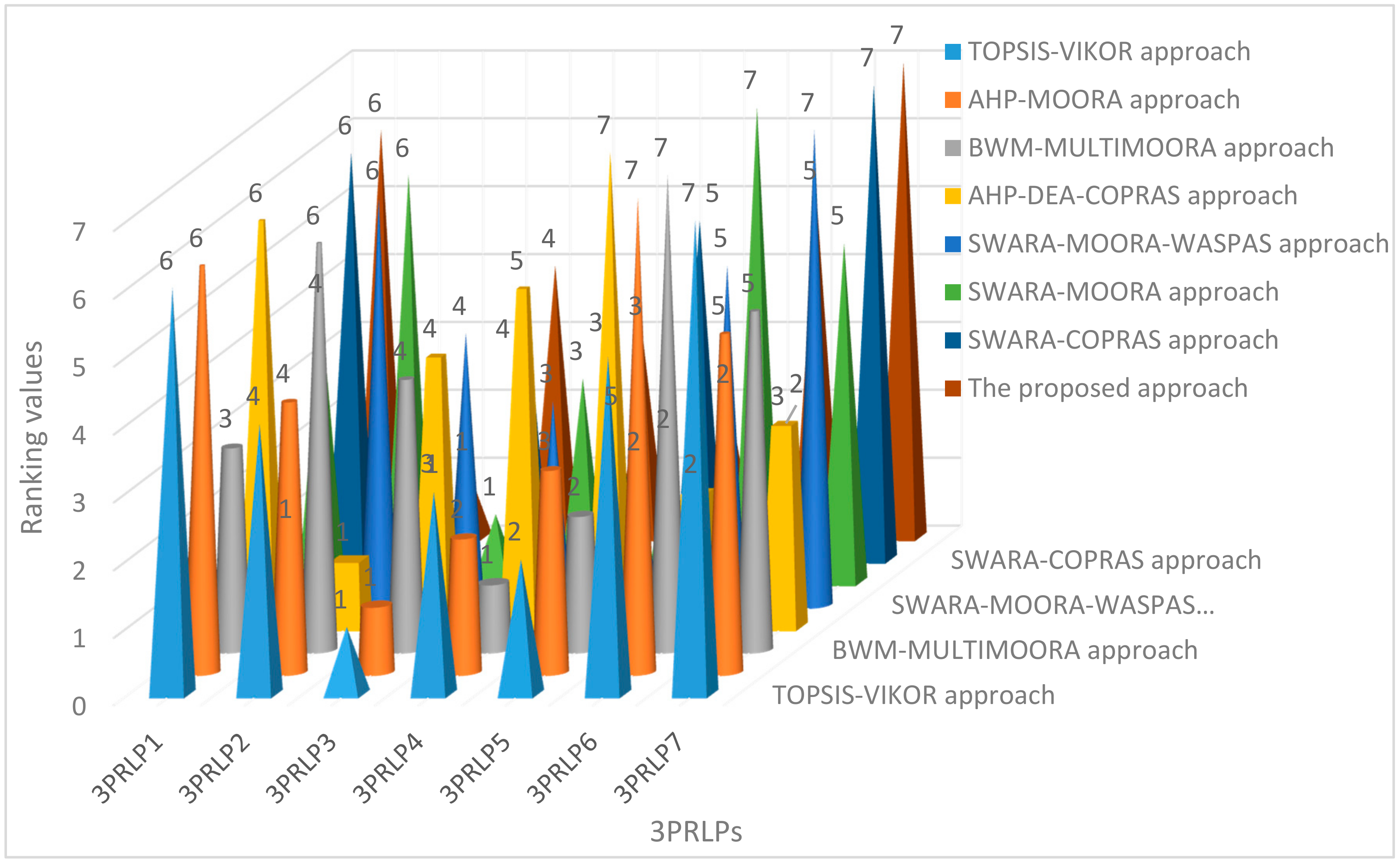
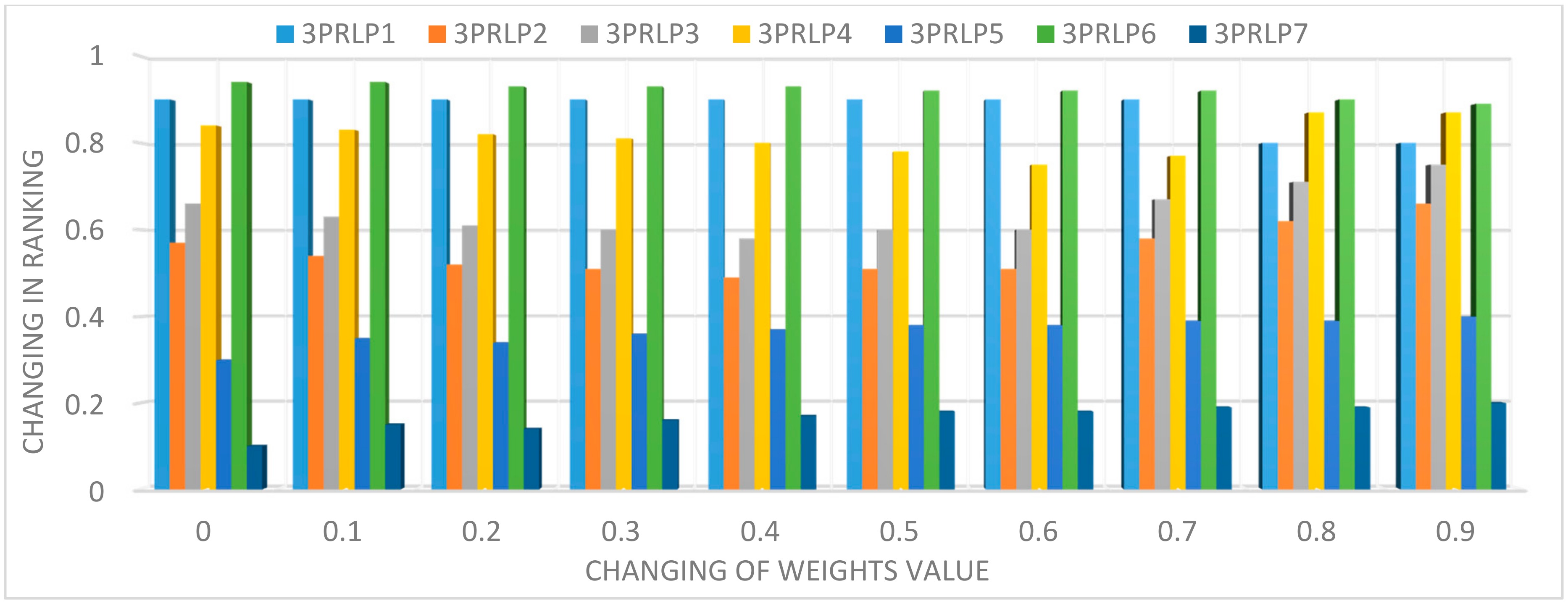
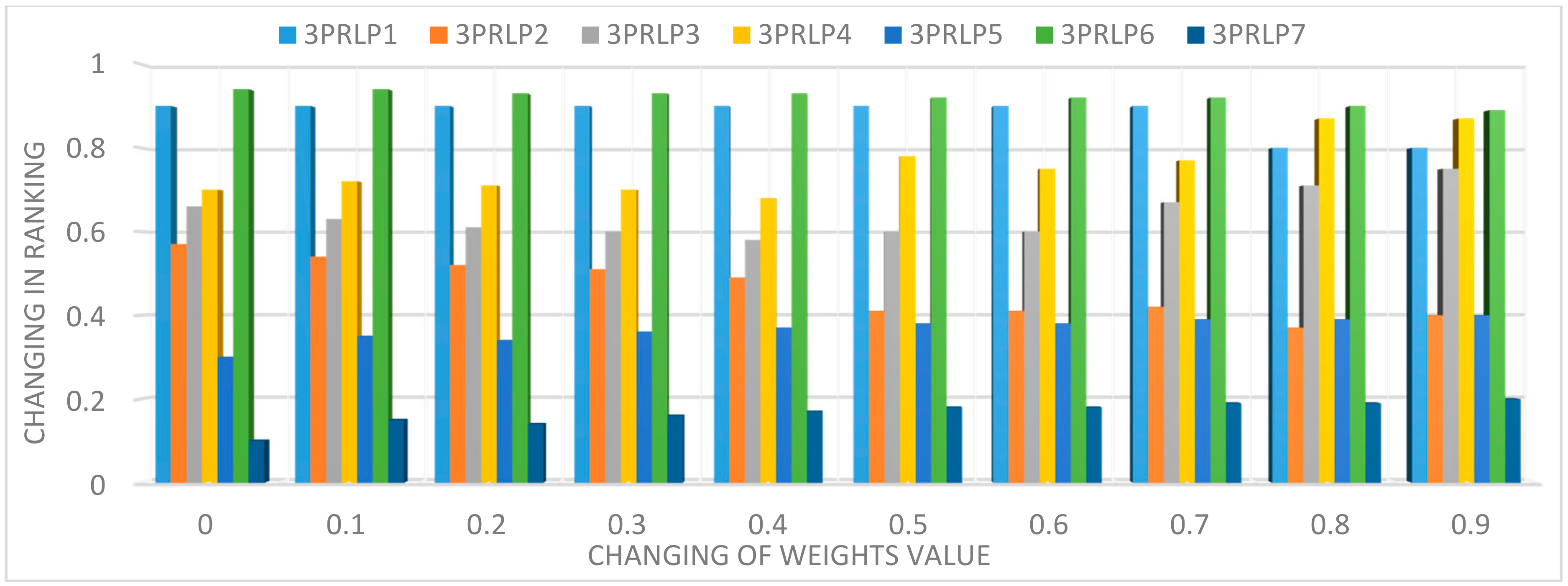
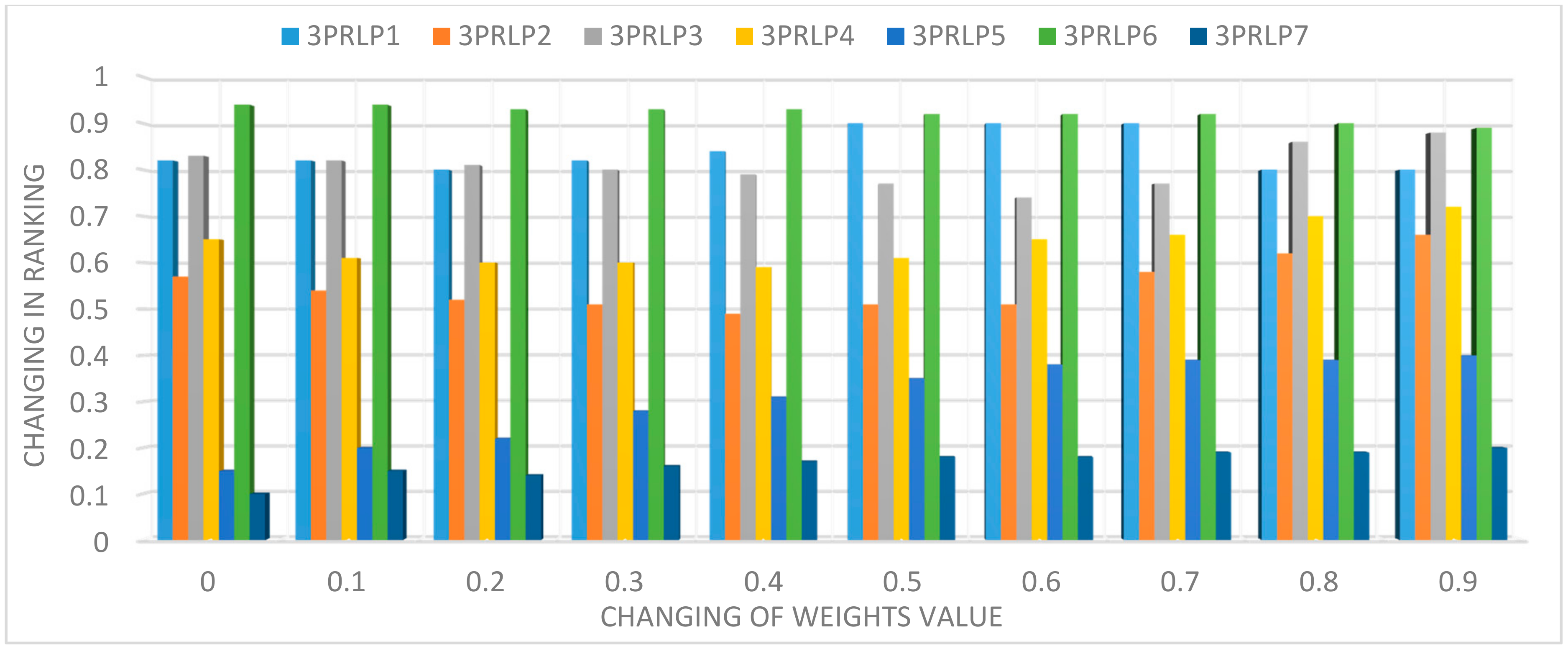
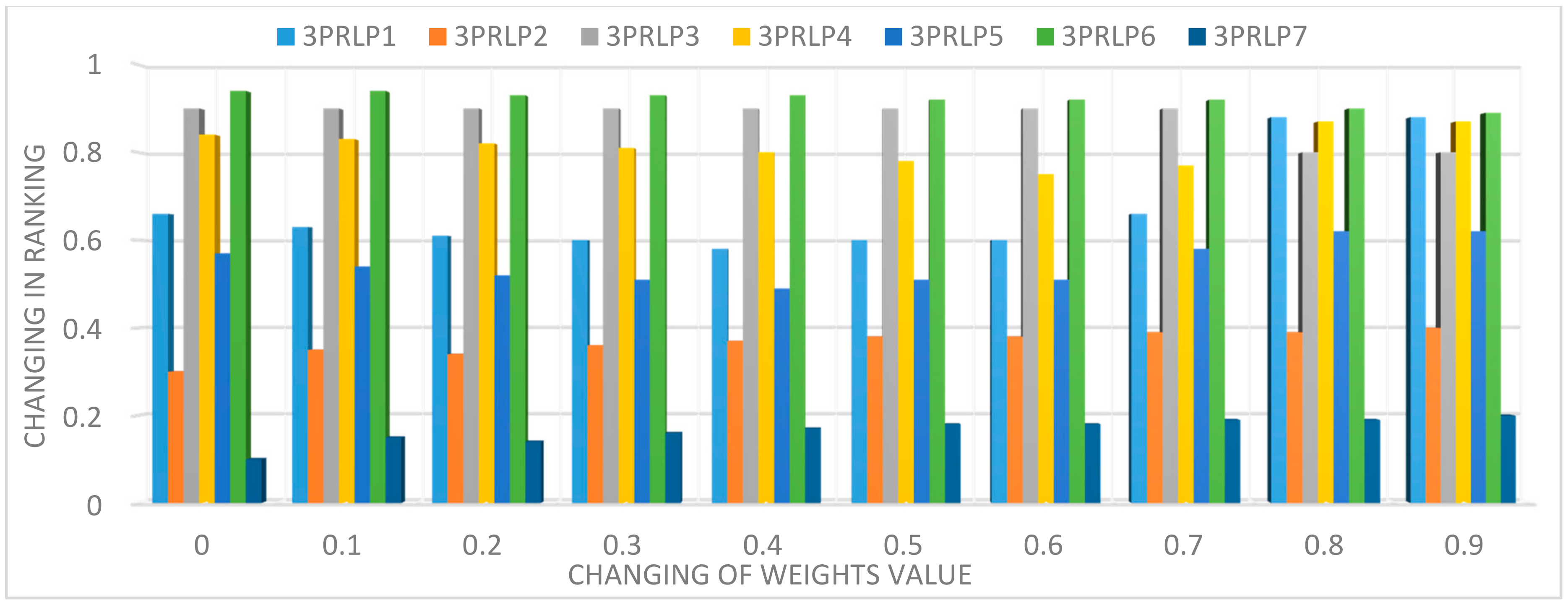
| Linguistic Scales | Abbreviations | T2NNs [(TT, TI, TF), (IT, II, IF), (FT, FI, FF)] |
|---|---|---|
| Weak importance | WIE | [(0.19, 0.29, 0.19), (0.59, 0.69, 0.79), (0.46, 0.74, 0.73)] |
| Just importance | JIE | [(0.39, 0.29, 0.26), (0.44, 0.56, 0.39), (0.46, 0.59, 0.54)] |
| Essential importance | EIE | [(0.64, 0.54, 0.56), (0.39, 0.44, 0.56), (0.36, 0.39, 0.34)] |
| Very strong importance | VS | [(0.79, 0.74, 0.69), (0.19, 0.16, 0.29), (0.16, 0.11, 0.21)] |
| Extremely preferred | EP | [(0.89, 0.86, 0.96), (0.09, 0.16, 0.11), (0.06, 0.07, 0.11)] |
| Linguistic Scales | Abbreviations | T2NNs [(TT, TI, TF), (IT, II, IF), (FT, FI, FF)] |
|---|---|---|
| Very poor | VPR | [(0.20, 0.20, 0.10), (0.65, 0.80, 0.85), (0.45, 0.80, 0.70)] |
| Poor | POR | [(0.35, 0.35, 0.10), (0.50, 0.75, 0.80), (0.50, 0.75, 0.65)] |
| Medium poor | MPR | [(0.50, 0.30, 0.50), (0.50, 0.35, 0.45), (0.45, 0.30, 0.60)] |
| Fair | FAI | [(0.40, 0.45, 0.50), (0.40, 0.45, 0.50), (0.35, 0.40, 0.45)] |
| Medium good | MGD | [(0.59, 0.46, 0.49), (0.19, 0.16, 0.24), (0.09, 0.24, 0.14)] |
| Good | GOO | [(0.69, 0.76, 0.79), (0.16, 0.19, 0.24), (0.11, 0.16, 0.19)] |
| Very good | VGD | [(0.96, 0.89, 0.94), (0.11, 0.11, 0.06), (0.06, 0.04, 0.06)] |
| Assembling Capability | Volume | Industrialization | Volume |
|---|---|---|---|
| Axle collection | 100,000 | Cylinder heads and blocks | 80,000 |
| Gearbox collection | 50,000 | Conveyor belts | 60,000 |
| Engine sets | 75,000 | Metal structures | 100,000 |
| Specialist No | Knowledge (Years) | Learning | Chief | Position |
|---|---|---|---|---|
| 1 | 6 | Master | Financial Management | Finance expert |
| 2 | 7 | PhD | Industrial Engineering | Project control engineer |
| 3 | 5 | Bachelor | Industrial Management | Industrial sector support |
| 4 | 5 | Master | Mechanical Engineering | R&D expert |
| 5 | 6 | Bachelor | Industrial Engineering | Logistics expert |
| 6 | 8 | Master | MBA Management | Vice of R&D |
| 7 | 7 | Master | Mechanical Engineering | Manufacture control |
| 8 | 9 | PhD | Financial Management | Finance expert |
| 9 | 5 | Master | Mechanical Engineering | Manufacture control |
| 10 | 6 | Master | Industrial Engineering | Logistics expert |
| Dimensions | EDI1 | NDI2 | SDI3 | RDI4 |
|---|---|---|---|---|
| EDI1 | - | 〈EPD〉 | 〈EIE〉 | 〈JIE〉 |
| NDI2 | 1/〈EPD〉 | - | 〈VSE〉 | 〈WIE〉 |
| SDI3 | 1/〈EIE〉 | 1/〈VSE〉 | - | 〈EIE〉 |
| RDI4 | 1/〈JIE〉 | 1/〈WIE〉 | 1/〈EIE〉 | - |
| Dimensions | EDI1 | NDI2 | SDI3 | RDI4 | Weights |
|---|---|---|---|---|---|
| EDI1 | 0.5 | 0.17 | |||
| NDI2 | 0.5 | 0.22 | |||
| SDI3 | 0.5 | 0.30 | |||
| RDI4 | 0.5 | 0.31 |
| Dimension Weight | EDI1 (0.17) | NDI2 (0.22) | ||||||||||
| Subindices | EQD11 | ECD12 | EED13 | EID14 | EFD15 | EAD16 | NGD21 | NRD22 | NED23 | NFD24 | NCD25 | NDD26 |
| Local weights | 0.10 | 0.11 | 0.18 | 0.16 | 0.21 | 0.23 | 0.11 | 0.09 | 0.14 | 0.19 | 0.23 | 0.24 |
| Global weights | 0.02 | 0.03 | 0.04 | 0.03 | 0.05 | 0.05 | 0.02 | 0.03 | 0.04 | 0.03 | 0.04 | 0.05 |
| Rank | 21 | 17 | 12 | 16 | 8 | 7 | 20 | 18 | 13 | 15 | 11 | 7 |
| Dimension weight | SDI3 (0.30) | RDI4 (0.31) | ||||||||||
| Subindices | SHD31 | SED32 | SOD33 | SSD34 | STD35 | ROD41 | RRD42 | RMD43 | RSD44 | |||
| Local weights | 0.10 | 0.14 | 0.16 | 0.23 | 0.37 | 0.24 | 0.19 | 0.26 | 0.31 | |||
| Global weights | 0.03 | 0.04 | 0.05 | 0.07 | 0.11 | 0.07 | 0.05 | 0.08 | 0.09 | |||
| Rank | 19 | 14 | 10 | 5 | 1 | 4 | 9 | 3 | 2 | |||
| 3PRLPs | Rank | |||
|---|---|---|---|---|
| 3PRLPs1 | 0.13 | 0.12 | 0.474065 | 2 |
| 3PRLPs2 | 0.20 | 0.08 | 0.278927 | 5 |
| 3PRLPs3 | 0.14 | 0.11 | 0.445539 | 4 |
| 3PRLPs4 | 0.13 | 0.11 | 0.465156 | 3 |
| 3PRLPs5 | 0.21 | 0.05 | 0.202659 | 6 |
| 3PRLPs6 | 0.08 | 0.22 | 0.739986 | 1 |
| 3PRLPs7 | 0.23 | 0.05 | 0.183166 | 7 |
| The MCDM Technique Applied in Their Paper | |||
| TOPSIS-VIKOR approach [5] | AHP–MOORA approach [4] | BWM-MULTIMOORA approach [36] | AHP-DEA-COPRAS approach [37] |
| Environment of the used approach | |||
| Rough set | Fuzzy | Fuzzy | Classic |
| The type of modification used in the approach | |||
| Hybridization | |||
| The persons responsible for expressing their opinions in the aforementioned studies | |||
| A collection of experts | |||
| Numeral of dimensions and their subindices | |||
| Thirteen dimensions | Four core dimensions and 23 subindices | Eight core dimensions and 24 subindices | Ten dimensions |
| Number of 3PRLPs | |||
| Thirty 3PRLPs | Nine 3PRLPs | Three 3PRLPs | Thirty 3PRLPs |
| Scales and numbers | |||
| Classic numbers | Fuzzy numbers and grey numbers | Fuzzy numbers | Grey numbers |
| Rating 3PRLPs by other approaches | |||
| Rating by TOPSIS-VIKOR approach 3PRLP6 > 3PRLP4 > 3PRLP1 > 3PRLP3 > 3PRLP2 > 3PRLP5 > 3PRLP7 | Rating by AHP-MOORA approach 3PRLP6 > 3PRLP4 > 3PRLP1 > 3PRLP2 > 3PRLP3 > 3PRLP7 > 3PRLP5 | Rating by BWM-MULTIMOORA approach 3PRLP3 > 3PRLP6 > 3PRLP4 > 3PRLP1 > 3PRLP2 > 3PRLP7 > 3PRLP5 | Rating by AHP-EDAS-COPRAS approach 3PRLP6 > 3PRLP1 > 3PRLP4 > 3PRLP5 > 3PRLP7 > 3PRLP2 > 3PRLP3 |
| Spearman rank correlation coefficient | |||
| 0.893 | 0.500 | 0.179 | 0.400 |
| The MCDM technique applied in their paper | |||
| SWARA-MOORA-WASPAS approach [40] | SWARA-MOORA approach [41] | SWARA-COPRAS framework [3] | The submitted model AHP-TOPSIS |
| Environment of the used approach | |||
| Classic | Fuzzy | Fuzzy | Neutrosophic |
| The type of modification used in the approach | |||
| Hybridization | |||
| The people responsible for expressing their opinions in the aforementioned studies | |||
| A group of experts | |||
| Case study | |||
| Mobile recycling in India | Plastic industry | Automotive industry | Automotive industry |
| Numeber of dimensions and their subindices | |||
| Ten dimensions | Four key sustainability dimensions including economic, environment, social, and risk and 23 subindices | Four key dimensions and 16 subindices | Four core sustainability dimensions including: economic, environment, social, and risk and safety and 21 subindices |
| Number of 3PRLPs | |||
| Nine 3PRLPs | Nine 3PRLPs | Seven 3PRLPs | Seven 3PRLPs |
| Scales and numbers | |||
| Classic numbers | Fuzzy numbers | T2NNs | |
| Rating 3PRLPs by other approaches | |||
| Rating by SWARA-MOORA-WASPAS approach 3PRLP1 > 3PRLP6 > 3PRLP4 > 3PRLP3 > 3PRLP2 > 3PRLP5 > 3PRLP7 | Rating by SWARA-MOORA approach 3PRLP4 > 3PRLP6 > 3PRLP1 > 3PRLP3 > 3PRLP2 > 3PRLP7 > 3PRLP5 | Rating by SWARA-COPRAS approach 3PRLP6 > 3PRLP1 > 3PRLP4 > 3PRLP3 > 3PRLP5 > 3PRLP2 > 3PRLP7 | Rating by the proposed model AHP-TOPSIS 3PRLP6 > 3PRLP1 > 3PRLP4 > 3PRLP3 > 3PRLP2 > 3PRLP5 > 3PRLP7 |
| Spearman rank correlation coefficient | |||
| 0.624 | 0.179 | 0.821 | - |
Publisher’s Note: MDPI stays neutral with regard to jurisdictional claims in published maps and institutional affiliations. |
© 2021 by the authors. Licensee MDPI, Basel, Switzerland. This article is an open access article distributed under the terms and conditions of the Creative Commons Attribution (CC BY) license (https://creativecommons.org/licenses/by/4.0/).
Share and Cite
Abdel-Basset, M.; Gamal, A.; Elhoseny, M.; Chakrabortty, R.K.; Ryan, M. A Conceptual Hybrid Approach from a Multicriteria Perspective for Sustainable Third-Party Reverse Logistics Provider Identification. Sustainability 2021, 13, 4615. https://doi.org/10.3390/su13094615
Abdel-Basset M, Gamal A, Elhoseny M, Chakrabortty RK, Ryan M. A Conceptual Hybrid Approach from a Multicriteria Perspective for Sustainable Third-Party Reverse Logistics Provider Identification. Sustainability. 2021; 13(9):4615. https://doi.org/10.3390/su13094615
Chicago/Turabian StyleAbdel-Basset, Mohamed, Abduallah Gamal, Mohamed Elhoseny, Ripon K. Chakrabortty, and Michael Ryan. 2021. "A Conceptual Hybrid Approach from a Multicriteria Perspective for Sustainable Third-Party Reverse Logistics Provider Identification" Sustainability 13, no. 9: 4615. https://doi.org/10.3390/su13094615







